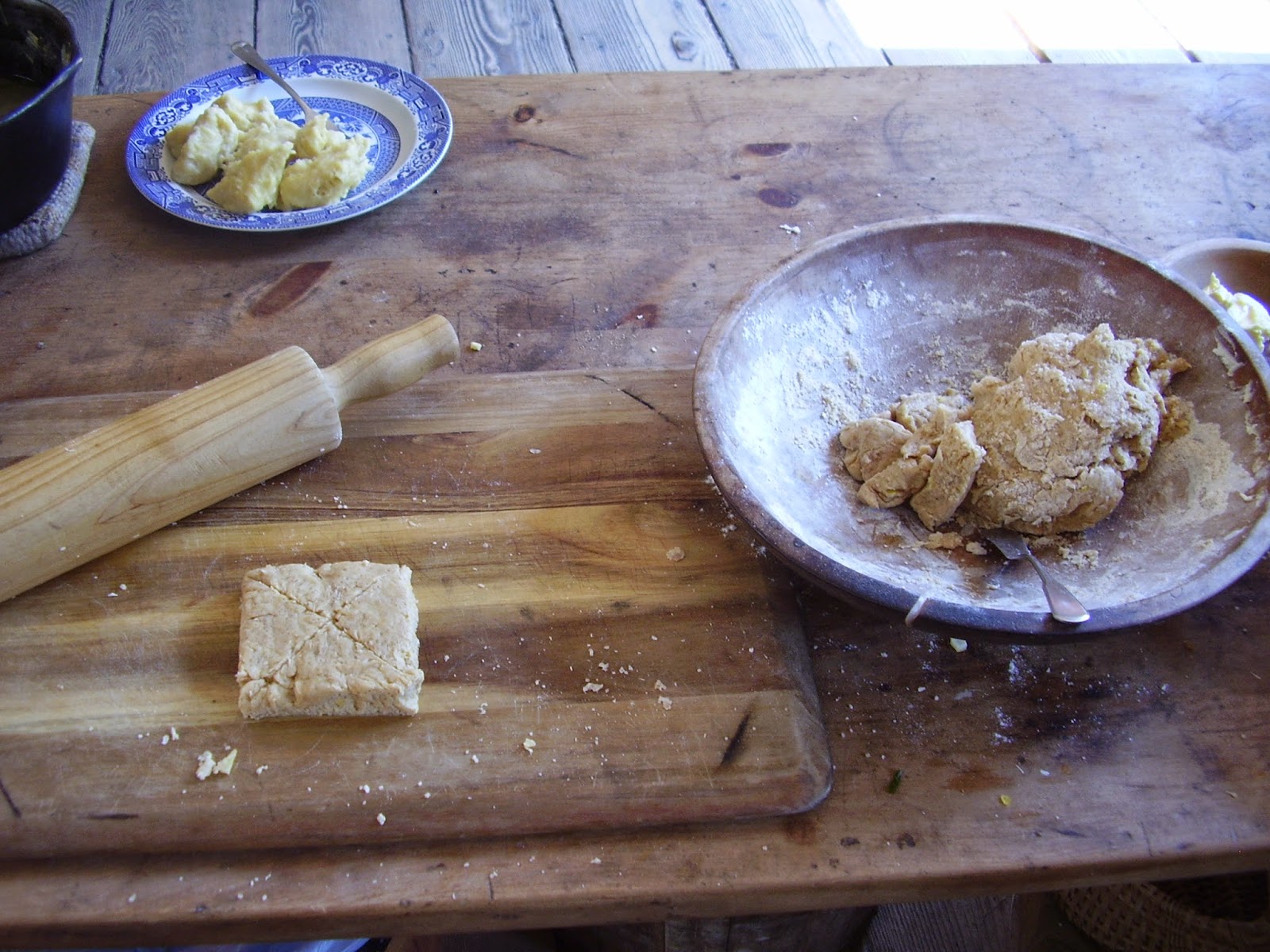The inaugural challenge--make a food (from a period recipe) which is referenced in a piece of literature. I considered making some of the tea dainties from "elegantly economical" Cranford... until I happened upon this 1841 reference and realized I needed to make more gingerbread. Using a math book as "literature" amused me too much to do anything else.
The receipt is Mrs. Beeton's (1861) white gingerbread. I've made up the "thick gingerbread" before, but hadn't tried this version. In a happy coincidence, I've recently learned to use the iron stove at Ft. Nisqually, and so decided to try out this receipt* in the period kitchen.
The results:
 |
| Dough and rolled sheet |
 |
| Baked Gingerbread |
 |
| 1854 Stove |
 |
| Staff lunch: leek stew & dumplings |
With no kitchen scales, I had to 'convert' the masses into cup measures (used the conversion tables from "Civil War Recipes" by Lily May and John Spaulding). Rubbed the butter into the flour, added the ginger, sugar, nutmeg, and lemon; dissolved the soda in warm milk (held it near the stove briefly to warm), then added the liquid to the dry ingredients, and worked it all into a paste. It was still a bit crumbly, so I added some of the lemon's juice (being out of milk), and the consistency improved nicely.
What I liked about this receipt was that several of the ingredients needed processing-- peeling the lemon and mincing the peel, grating the nutmeg, and so forth. It meant that I was actually doing activities for the fort visitors to see, instead of waiting while the cake baked or the stew stewed. (Actually, I was waiting on the stew while working on the gingerbread-- multitasking!).
Besides the lemon juice, my other deviation was in regards the 'pounded loaf sugar'. I did get out the mortar and pestle and start working on the some of the cone sugar that was available. After less than a quarter of the needed amount, I surrendered, and switched to the 'crash sugar'. Much less obnoxious.
The gingerbread baked very nicely in the oven, either because I finally worked out the right rate of adding wood to the fire, or because the thin sheets are better suited to it--when I tried "thick gingerbread" in this oven it scorched badly without the center ever cooking. The shortbread, however, turned out well, so that was the size I aimed for in making the gingerbread (this also ensured that it fit into the available baking tins).
With the oven going anyway, I decided to make lunch for the hard-working staff members. The garden had a plentiful supply of leeks just now, so I did a leek & potato stew (improvised, with carrots and onion, and herbs from the garden) and served it with egg dumplings (from "Civil War Recipes", attributed to Godey's, 1869).
Challenge Summary:
The Challenge: A Literary Dish
The Recipe: White Gingerbread, Mrs. Beeton's Book of Household Management
The Date/Year and Region: Recipe is English, published 1861
How Did You Make It: Rub butter into flour, add other dry ingredients; convert into a paste with liquid ingredients, roll out and cut into cakes, bake in a moderate oven 15-20 minutes.
Time to Complete: Uncertain (no clock in period kitchen, probably 20-ish minutes to prepare and another 20 to bake each pan)
Total Cost: Unknown (I had the spices, the lemon and the gill, ie half cup, of milk on hand); flour and sugar are provided by the fort.
How Successful Was It?: Tasted nice and spicy. The lemon/nutmeg combination went well with the ginger, even if you aren't expecting lemon peel in gingerbread (or expecting gingerbread to be so pale). I was mostly relieved that it cooked through without burning on the outsides (though the first pan had a few edges need to be cut off); it all got eaten, so I take it the product was acceptable.
The Recipe: White Gingerbread, Mrs. Beeton's Book of Household Management
The Date/Year and Region: Recipe is English, published 1861
How Did You Make It: Rub butter into flour, add other dry ingredients; convert into a paste with liquid ingredients, roll out and cut into cakes, bake in a moderate oven 15-20 minutes.
Time to Complete: Uncertain (no clock in period kitchen, probably 20-ish minutes to prepare and another 20 to bake each pan)
Total Cost: Unknown (I had the spices, the lemon and the gill, ie half cup, of milk on hand); flour and sugar are provided by the fort.
How Successful Was It?: Tasted nice and spicy. The lemon/nutmeg combination went well with the ginger, even if you aren't expecting lemon peel in gingerbread (or expecting gingerbread to be so pale). I was mostly relieved that it cooked through without burning on the outsides (though the first pan had a few edges need to be cut off); it all got eaten, so I take it the product was acceptable.
How Accurate Is It?: Used cups instead of weighing ingredients, substituted crash sugar for loaf sugar, used pre-ground ginger, added lemon juice for more liquid.
*One of the period 'advice' books I've read (Miss Leslie's, I believe) has a short tirade on 'recipe' referring to pharmaceutical preparations and 'receipt' to food products.

No comments:
Post a Comment
Thanks for commenting!